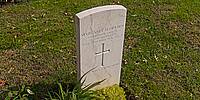
why....only her?
Bellaria, 96, 20151 Milano MI - Italy
September, 30th 2025 - 13,30 local time
© 2025 Roberto Mancuso, All Rights Reserved.
from an article by Federica Venni in *La Repubblica*, August 20, 2017
Mr. Norman, Sergeant Ellis, Corporal Major Cummings, Private Nelson, Mr. Heads, Specialist Officer S. G. Lee, Gunner Darbyshire, Squadron Leader Mac Glashan, Lieutenant G. F. J. Anstee, Pilot Rosenberg. And then there’s her — Margaret, the only woman.
We are at the English War Cemetery, next to Trenno Park: here, in this meticulously kept patch of green overlooking Via Cascina Bellaria, lie 421 soldiers of the Second World War who contributed to the liberation of Milan. Among them, the only woman — Margaret Helen Fielden. Very little is known about her; her death, which occurred after the conflict had already ended, on September 29, 1945, is shrouded in mystery.
Her grave is in one of the front rows, near the center of the cemetery: red and yellow flowers brighten the white marble of the headstone. Around her rest over four hundred soldiers, airmen, and sailors who fought in the Commonwealth armies between 1943 and 1945. They came from Great Britain, South Africa, Australia, New Zealand, Canada, India, and East Africa. Twenty-seven of them have never been identified.
Of Margaret Fielden, however, we do know that she was only 28 when she died, and that she was a professional physiotherapist, a member of the Chartered Society of Physiotherapy — one of England’s largest professional organizations, founded at the end of the nineteenth century by four nurses and now counting over 53,000 members. Born and raised in Godalming, a town of about 20,000 inhabitants in Surrey, some sixty kilometers southwest of London, Margaret was in Italy during the war, serving with the 64th British General Hospital, one of the Allied medical units operating mainly in Africa and Italy.
The records of the Commonwealth War Graves Commission — the intergovernmental organization still responsible for identifying, registering, and maintaining the graves and memorials of Commonwealth armed forces personnel who died during the First and Second World Wars — tell us the essentials about her: we know her parents were named Edith Esther Fielden and Perceval Fielden. Her father’s name — though only a conjecture — recalls the musician Thomas Perceval Fielden (1883–1974), pianist, music teacher, and headmaster of three schools, including Charterhouse College in Godalming, Margaret’s hometown. He also served, between 1943 and 1945, in the Royal Naval Volunteer Reserve as a sergeant.
Margaret’s name stands out among those of so many soldiers, both in the Commonwealth casualty register and in the list of graves at the Trenno cemetery. The circumstances of her death remain unknown, but it is likely that she fell ill after the end of the conflict, while continuing to serve in the British medical unit in Italy. Otherwise, it would be difficult to explain her burial here, in this corner of English grass on the outskirts of the city, “donated by the Italian people for the eternal rest of the sailors, soldiers, and airmen to whose memory honor is here rendered.”
However, I read on social media that someone claimed there was nothing mysterious about it, that they knew the family and were in constant contact with the relatives... I haven’t been able to find that post again, so I can’t cite the exact source — but I did read it.
Kandao 3 Ultra, kandao software, photoshop, ptguii, pano2vr, monopod with small base


 Tap or click the zoom icon in the bottom right corner of the picture to switch between in-page and fullscreen view
Tap or click the zoom icon in the bottom right corner of the picture to switch between in-page and fullscreen view